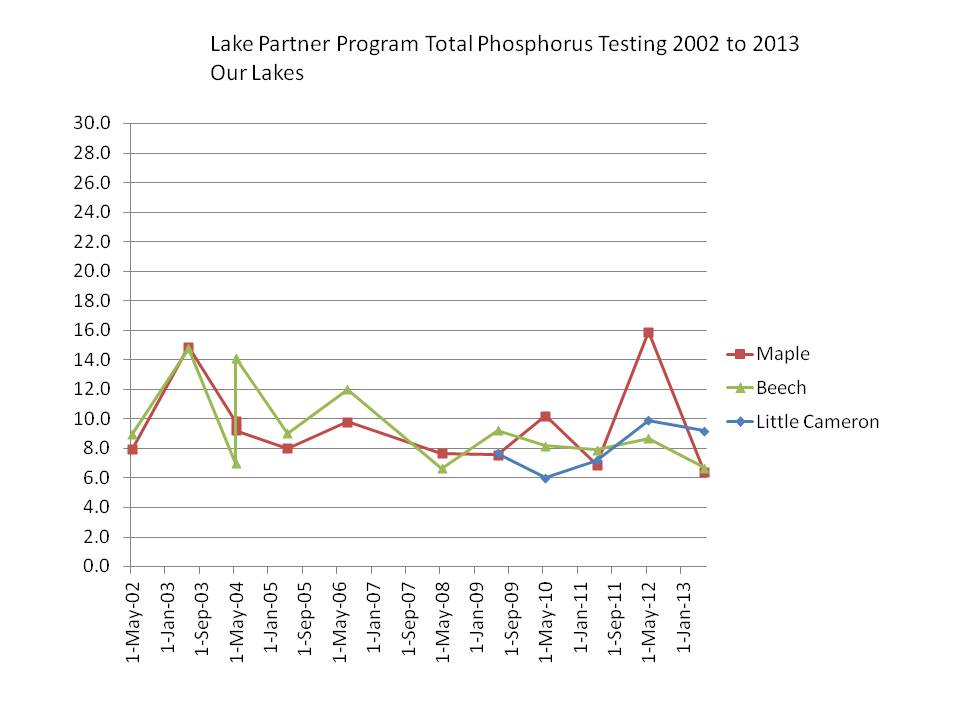MBC Lakes Water Quality
Water quality is often taken for granted by lake area property owners – until, that is, a problem occurs. MBC has been very fortunate to have dedicated volunteers testing the water quality of Maple & Beech lakes for more than a decade, through the Ministry of Environment’s Lake Partner Program. Our volunteers take samples from spring to fall & send the samples & results to the MOE for tabulation and review. The graphs in this section show the results of these tests and indicate that both lakes are “healthy”.
To get more detail and see other lake ratings visit: www.foca.on.ca/lake-partner.
Note: Phosphorous readings indicate the amount of nutrients in a lake and relates to the ability for algae to grow. As phosphorous levels increase, water clarity decreases due to algal growth. Lakes with less than 10ug/l total phosphorous (TP) rarely have problems with algae & are called Oligotrophic. Lakes with between 10 & 20 ug/l TP are called Mesotrophic and can show a range of characteristics, from clear (at levels close to 10ug/l) to moderate algal blooms (at the 20ug/l). Lakes with 20+ug/l are called Eutrophic and may experience persistent nuisance algal blooms.
The maintenance of acceptable Calcium (Ca) levels in our lakes is also very important; insufficient levels of Ca will prevent the proper formation and reproduction of crustaceans and bivalves that are important to the health of our lakes. One of the most important of these creatures is the tiny Daphnea which does so much to control algae.
Secchi Disc readings measure the light penetration (clarity) of a lake. As mentioned above, high phosphorous readings usually result in lower water clarity (due to high nutrient content) but there are also other reasons for reduced clarity in our lakes. Runoff and shoreline erosion both create non biological turbidity. Invading species such as Zebra mussels detrimentally increase water clarity through their filtering action which removes an important food source for young fish. This is why it is important to regularly conduct both TP & Secchi Disc readings.
All of these measures and levels are affected by climatic change – warming, in particular, can accelerate the formation of harmful algal blooms. Because of this, and other factors, Phosphorous levels once thought to be “acceptable” are no longer seen as a guarantee.
What can you do to protect our water quality?
- Naturalize your shoreline to create a barrier between the lake and your home / cottage
- To learn more visit the FOCA website: www.foca.on.ca/environment
- Maintain your septic system,
- minimize water use
- always use environmentally certified cleaning products
- have your system pumped and checked every 3-5 years
- never put anything down your drains that can kill bacteria – bleach, antibacterial soaps etc
- Never wash in the lake – at one time this was considered a “cottage activity” but is now known to be harmful to our lakes
- Obey Boating safety regulations – < 10kph (6mph) within 30 meters (100 feet) of the shore to minimize shoreline erosion.
- Minimize the impact of docks etc on water quality (treated wood) and near shore fish habitat
- Prevent the spread of invasive species – clean your boat/engine properly if you move from lake to lake and never release live bait into the lake.


As well as the LPP program, the MBC carries out sampling for Coliform and E-coli on our lakes. These numbers can give us a picture of another measure of lake health and can point out potential problems with septic systems and waste handling on and upstream of our lakes. These samples and analyses are undertaken by MBC volunteers and are paid for by MBC member dues.


